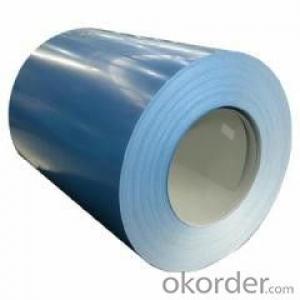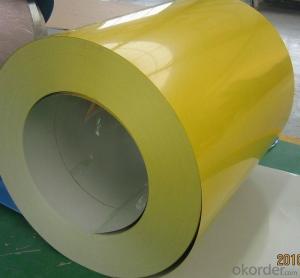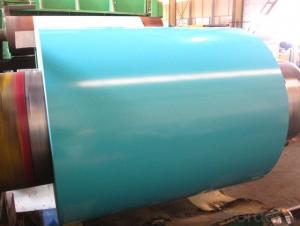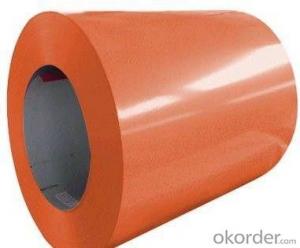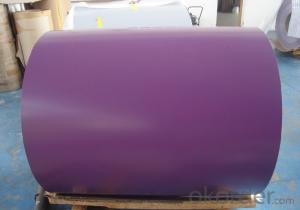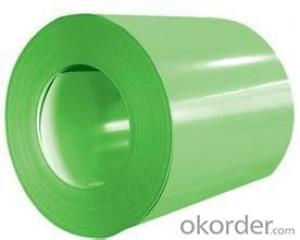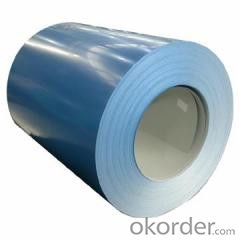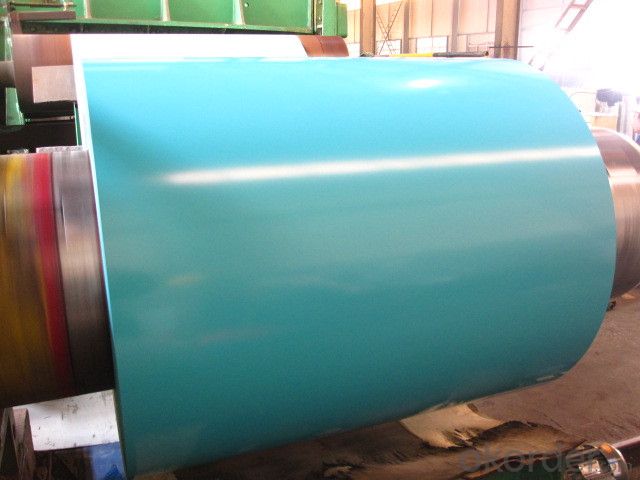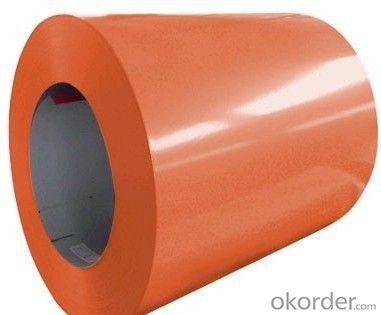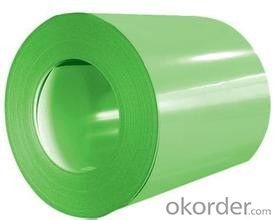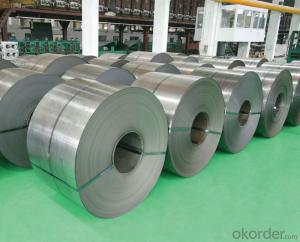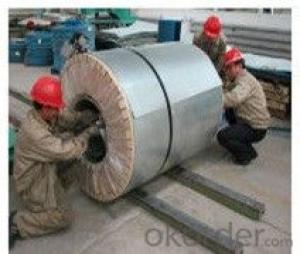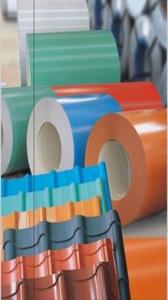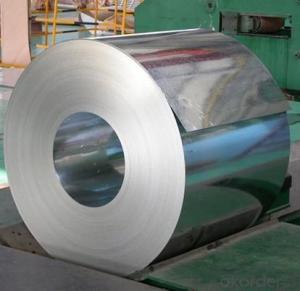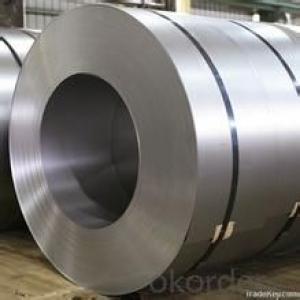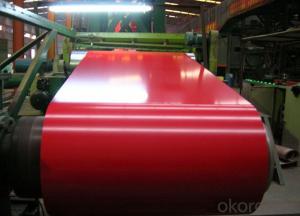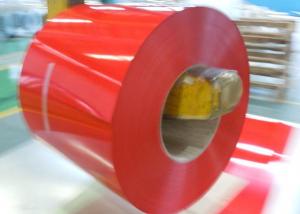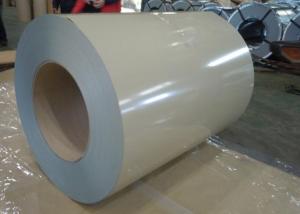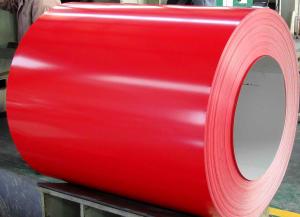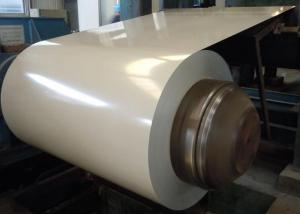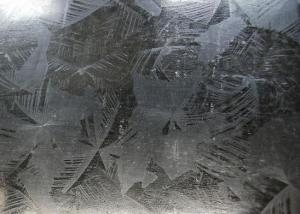Environmental Color Coated Galvanized Steel Coil
- Loading Port:
- Shanghai
- Payment Terms:
- TT OR LC
- Min Order Qty:
- 1 m.t.
- Supply Capability:
- 30000 m.t./month
OKorder Service Pledge
OKorder Financial Service
You Might Also Like
PPGI Coil
Specification
Thickness | 0.15mm-2.0mm |
Thickness tolerance | +/- 0.02mm |
Width | 600mm-1250mm |
Width tolerance | +/-2mm |
Zinc coating | Z40-Z275 |
Color | Grey white, sea blue, red or any RAL standard |
Painting | Top: 20+/-5um Back: 5mic---8mic |
Standard | ASTM, AISI, DIN, GB,JIS |
Material | SGCC,SGCD,SECC,SECD,DX51D+Z, S350GD, S450GD, S550GD |
Technique | Cold rolled, hot-dipped galvanizing, color coated, galvanized, |
Payment | T/T, L/C |
Surface Structure | Galvanized, zero spangle, regular spangle or normal spangle |
Surface treatment | Chromate and oiled, chromate and non-oiled |
Packing | Export standard, or according to client requirement |
Min order | 50 tons |
Coil weight | 3-6tons or as client requirement. |
Coil ID | 508/610mm |
Chemical Composition | ||||||
GRADE | C | Si | Mn | P | S | Ti |
SGCC/DX51D+Z | ≤0.10 | ≤0.50 | ≤0.60 | ≤0.10 | ≤0.030 | ≤0.020 |
DX52D+Z | ≤0.10 | ≤0.50 | ≤0.60 | ≤0.10 | ≤0.030 | ≤0.020 |
SGCD/DX53D+Z | ≤0.10 | ≤0.30 | ≤0.50 | ≤0.05 | ≤0.030 | ≤0.020 |
SGCE/DX54D+Z | ≤0.10 | ≤0.30 | ≤0.30 | ≤0.03 | ≤0.020 | ≤0.020 |
DX56D+Z | ≤0.10 | ≤0.30 | ≤0.30 | ≤0.03 | ≤0.020 | ≤0.020 |
Structural | ≤0.20 | ≤0.60 | ≤1.70 | ≤0.10 | ≤0.045 | |
Mechanical Properties | |||
Grade | Yield Strength MPa | Tensile Strength MPa | Elongation % |
SGCC(DX51D+AZ) | ≥205 | ≥270 | ≥22 |
SGCD(DX52D+AZ) | ≥140 | ≥270 | ≥38 |
S250GD+AZ | ≥250 | ≥330 | ≥19 |
S350GD+AZ | ≥350 | ≥420 | ≥16 |
Painting Category/Structure
Category of Painting | Item | Code | |
Polyester | PE | ||
High-durability polyester | HDP | ||
Silicon modified polyesters | SMP | ||
Polyvinylidene fluoride | PVDF | ||
Easy-Cleaning | — | ||
Painting Structure | Top surface | Bottom surface | |
Primer coating | No coating | 1/0 | |
Primer coating | Primer coating | 1/1 | |
Primer coating + Finish coating | No coating | 2/0 | |
Primer coating + Finish coating | Primer coating or single back coating | 2/1 | |
Primer coating + Finish coating | Primer coating + Finish back coating | 2/2 | |
Standard
Quality | Q/BQB 440-2003 | JISG3312-1994 | EN 10326-2004 | ASTM A653-02a |
EN 10327-2004 | (BASE PLATE) | |||
(BASE PLATE) | ||||
Commercial Steel | TDC51D | CGCC |
DX51D+Z/AZ | CS Type A/B/C |
Forming Steel | TSt01,TSt02,TSt03 | CGCD1 | FS Type A, Type B | |
Drawing | TDC52D /TDC53D | DX52D+Z/AZ | DDS TYPE A/C | |
Steel | DX53D+Z/AZ | |||
Structural | TS250GD TS280GD TS340GD TS440GD TS550GD | CGC400 CGC570 | S280D+Z/AZ | SS275 |
Steel | TS350GD TStE34 | CGC440 | S350D+Z/AZ | SS340 Class1 |
Applications
Construction | Outside | Workshop, agricultural warehouse, residential precast unit, corrugated roof, roller shutter door, rainwater drainage pipe, retailer booth |
Inside | Door, doorframe, light steel roof structure, folding screen, elevator, stairway, vent gutter | |
Electrical appliance | Refrigerator, washer, switch cabinet, instrument cabinet, air conditioning, micro-wave oven, bread maker | |
Furniture | Central heating slice, lampshade, desk, bed, locker, bookshelf | |
Carrying trade | Exterior decoration of auto and train, clapboard, container, isolation board | |
Others | Writing panel, garbage can, billboard, timekeeper, typewriter, instrument panel, weight sensor, photographic equipment | |
- Q: like building steel beams. i'm pretty sure with a sawzall.
- Most I-beams are manufactured in a factory by rolling the red hot steel billet through several sets of rolls till the I-beam takes it's final shape. All we normally do to a factory stock I-beam is cut it to length, trim the ends, punch out the mounting holes and or weld on shear tabs. Some I-beams like tapered ones are built from scratch in the shop using plate steel. In fabricating in the shop, a plasma cutter or cutting torch is used along with a hydraulic plate shear. Repairs during erection, usually a cutting torch because you are several stories in the air. If the beam has to be taken to the ground, still a cutting torch because on a job site power availability is poor to connect a plasma cutter. Wingman
- Q: Ok, I need two negative facts about steel wheels and two for aluminum wheels. im designing a wheel for a project in design and draw for production class. Also if you find a web site that you got the info from plz refrence it i need to write down the source of the info, but if you can't its ok. Thanks
- Negative facts for steel wheels: (1) Not as many style choices as aluminum. (2) Rust easily even when painted or powder coated, due to rock chips. (3) Heaver than aluminum, as far as fuel economy. Negative facts for aluminum wheels: (1) More sensitive to proper torquing of lug nuts. IE torque must be checked more often. (2) Susceptible to impact damage from road hazards much more than steel. (3) Need constant attention to prevent oxidation. Are these what you are looking for? I hope so. Wingman
- Q: Is there a type of spray paint that would work on Stainless steel?That would also be permenant or at least make it through a wash or two?
- I've also learned something today! Good luck and have fun!
- Q: What is the major disadvantage of hardened steel? Do you think this form of iron would be wear resistant and retain a sharpened edge?
- a disadvantage is the fact that the cold forming capability of this steel
- Q: So today I was bored and was reading a shotgun shell box,the box was slug 12ga.I noticed it said not to be used in Damascus steel or twist barrel.It was to my understanding that Damascus steel is very strong and many stories came from what it could cut when used in a blade or sword.The little bit of info that i could find was that Damascus used earlier in the turn of the century on shotguns should not be fired unless special maintenance has been given and check out by gunsmith.So is Damascus not strong like i thought and not be able to handle higher pressure or why the reason for the warning?*
- Damascus steel in gunmaking Prior to the early 20th century, all shotgun barrels were forged by heating narrow strips of iron and steel and shaping them around a mandrel.[22][23] This process was referred to as laminating or Damascus and these barrels were found on shotguns that sold for $12.[22][23] These types of barrels earned a reputation for weakness and were never meant to be used with modern smokeless powder, or any kind of moderately powerful explosive.[23] Because of the resemblance to Damascus steel, higher-end barrels were made by Belgian and British gun makers.[22][23] These barrels are proof marked and meant to be used with light pressure loads.[22] Current gun manufacturers such as Caspian Arms make slide assemblies and small parts such as triggers and safeties for Colt M1911 pistols from powdered Swedish steel resulting in a swirling two-toned effect; these parts are often referred to as Stainless Damascus.[24]
- Q: what do you think about producebility of low density steel? for example: can density of 1020 steel (or ony others) be decreased without any loss of other properties.
- If a material has a lower density than steel, then it isn't steel.
- Q: Is this a strong, durable piece of steel that can take abuse? I'm thinking about using it on a small project.
- Hey Ramzi, I met this chick and was wondering if you could tell me if she would make a good wife. Here's your answer: Big Blue, there are a hundred bits of information I would need, and even then there are mysterious factors that affect the outcome. So basically, I don't have the slightest idea. My answer to your question is exactly the same. Without showing exactly how the Simpson Tie is being used, there is obviously no way to know if it is suitable. Can it be tempered? Sure, but again, I give it a 99% likelihood it will not help in your application. Explain it in detail in 5 to 10 sentences. Give us diagrams and photos. If you can't or won't do that, here's Plan B. Head over to your nearest machine shop, and ask the machinist what he thinks. He will ask the probing questions to understand the needs of the part. It is likely a Simpson Tie won't do it but he is in a good position to suggest a workable approach, and then sell it to you. By the way, if this is a load-supporting member of a motorcycle or some other fast moving vehicle, be prepared to get kicked out of the machine shop. The risk of making an error is high and the outcome extremely dangerous. I would not risk a million dollar lawsuit in order to sell you a $10 part.
- Q: How are steel coils inspected?
- Steel coils are inspected through various methods such as visual inspection, dimensional measurement, and non-destructive testing techniques. Visual inspection involves the examination of the coils for any surface defects, such as scratches, dents, or rust. Dimensional measurement ensures that the coils meet the required specifications in terms of thickness, width, and diameter. Non-destructive testing techniques like ultrasonic testing, magnetic particle inspection, and eddy current testing are used to detect any internal defects or discontinuities in the steel coils without causing any damage to the material. These comprehensive inspection methods ensure the quality and integrity of steel coils before they are used in various industries.
- Q: Question about steel type used in bridges.?
- Do you mean galvanized steel?
- Q: What are the different methods of skin pass rolling for steel coils?
- There are several methods of skin pass rolling for steel coils, each with its own unique characteristics and benefits. Some of the most common methods include: 1. Dry Skin Pass: In this method, the steel coil is passed through a set of rolls without the application of any lubricant or coolant. This helps to improve the surface finish of the steel by reducing the thickness variations and imparting a smoother texture. 2. Wet Skin Pass: This method involves the application of a water-based emulsion or coolant during the skin pass rolling process. The coolant helps to reduce friction and heat generated during rolling, resulting in improved surface quality and reduced risk of surface defects. 3. Electrolytic Skin Pass: This technique utilizes an electrolytic solution during skin pass rolling. The steel coil is immersed in the solution, and an electric current is applied to the coil, resulting in controlled surface etching. This method is particularly effective in improving surface cleanliness and removing oxide scale. 4. Temper Mill Skin Pass: This method combines skin pass rolling with a tempering process. The steel coil is rolled through a series of rolls, followed by a heating and cooling process to achieve the desired mechanical properties and surface finish. This method is commonly used for high-strength and automotive-grade steel coils. 5. Tension Leveling: In this method, the steel coil is passed through a series of rolls under high tension. This elongates the steel and helps to reduce residual stresses and shape defects, resulting in improved flatness and dimensional stability. It is important to note that the choice of skin pass rolling method depends on factors such as the desired surface finish, required mechanical properties, and the type of steel being processed. Each method has its own advantages and limitations, and manufacturers typically select the most appropriate method based on their specific requirements.
Send your message to us
Environmental Color Coated Galvanized Steel Coil
- Loading Port:
- Shanghai
- Payment Terms:
- TT OR LC
- Min Order Qty:
- 1 m.t.
- Supply Capability:
- 30000 m.t./month
OKorder Service Pledge
OKorder Financial Service
Similar products
Hot products
Hot Searches
Related keywords
